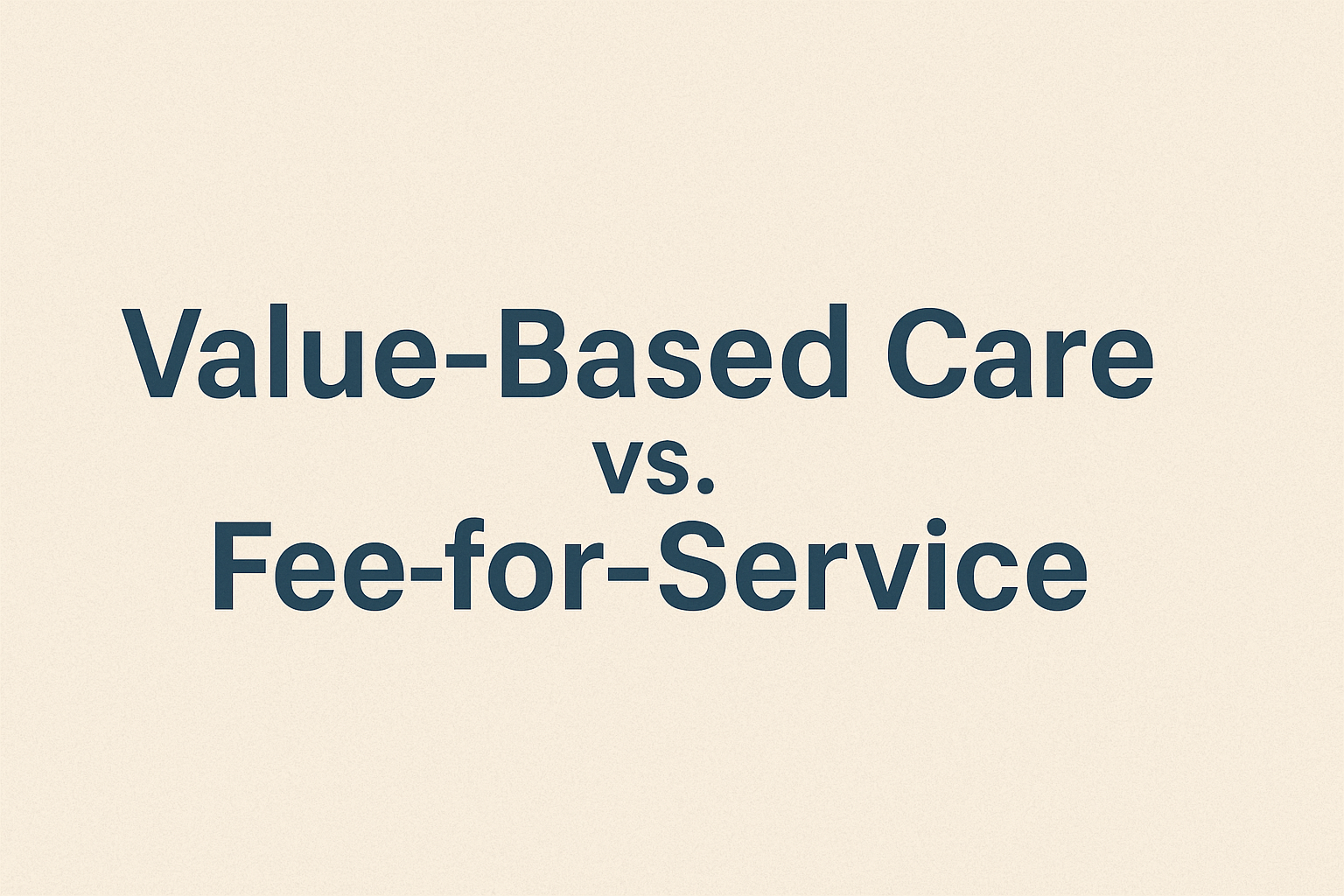Introduction
Healthcare in the United States is undergoing a structural transformation. For decades, we have operated under a fee-for-service (FFS) model, one that rewards volume, not necessarily value. This model has shaped everything from how care is delivered, to how providers are paid, to how patients interact with the healthcare system. But as costs rise, outcomes remain uneven, and consumers demand more transparency and accountability, the industry is increasingly turning its attention to an alternative: value-based care (VBC).
This essay aims to help healthcare associates across disciplines understand the core differences between these two models. It will explore their historical roots, underlying incentives, impact on patient outcomes, financial implications, and future trajectories. Whether you are a clinician, an administrator, or an analyst, grasping this distinction is essential to navigating the future of care delivery.
Understanding the Fee-for-Service Model
The fee-for-service model is relatively straightforward. Providers are reimbursed for each service rendered, whether it’s a diagnostic test, a surgical procedure, a consultation, or a hospital stay. The more services performed, the more revenue generated. On the surface, this appears logical: work performed equates to compensation received.
However, this model comes with inherent limitations. Because payment is tied to volume, not outcomes, it creates a perverse incentive structure. Unintentionally, it can encourage overtreatment or the overuse of diagnostic tools, even when clinical necessity is uncertain. Conversely, preventive care and patient education—services that often reduce long-term costs—are under-incentivized because they are not as easily billable or immediately lucrative.
Historically, FFS took root because it aligned with the industrial age model of work: inputs equal outputs. It gave providers autonomy to treat patients as they saw fit and helped build the infrastructure of modern healthcare. But in an era marked by chronic disease, aging populations, and rising consumer expectations, this model no longer fits the challenges we face.
The Rise of Value-Based Care
In contrast, value-based care is a model that rewards providers for the quality, rather than the quantity, of care. The goal is to improve health outcomes while controlling costs. Rather than being paid for every MRI or office visit, providers are compensated based on their ability to prevent complications, coordinate care, and enhance the overall health of populations.
At its heart, value-based care seeks to align incentives across payers, providers, and patients. It emphasizes integrated care, evidence-based practices, and accountability. Programs such as Medicare’s Shared Savings Program (MSSP), Accountable Care Organizations (ACOs), bundled payments, and Patient-Centered Medical Homes (PCMHs) are all examples of how this model is being implemented.
Under VBC, performance is measured through a variety of metrics. These may include hospital readmission rates, preventive screenings, chronic disease management, and patient satisfaction scores. Financially, this can mean shared savings, bonuses for meeting quality targets, or penalties for poor outcomes. In many arrangements, providers take on a certain degree of risk—if they exceed spending benchmarks without improving outcomes, they may lose money.
Financial Implications and Risk Sharing
One of the most significant differences between these models lies in financial risk. In FFS, risk is largely absorbed by the payer. Providers are guaranteed payment for services rendered, regardless of outcomes. In value-based care, the risk is increasingly shared—or even shifted—toward the provider.
This shift introduces a new operational reality. Providers must invest in infrastructure that supports coordination, data analytics, and population health management. Electronic health records must be interoperable. Clinical teams must collaborate across specialties. Administrative teams must track and report performance data. All of this requires resources, training, and a reorientation of organizational culture.
At the same time, value-based arrangements create the potential for more predictable, and even enhanced, revenue streams. By reducing unnecessary utilization and improving efficiency, high-performing systems can share in the savings they help create. Some models offer upfront care coordination payments or capitated rates, giving organizations flexibility to deploy resources in a way that best meets patient needs.
Impact on Clinical Behavior and Patient Engagement
The financial incentives in each model shape how clinicians approach patient care. Under FFS, the incentive is to do more. That can mean frequent office visits, extensive testing, and fragmented care. It may lead to faster throughput in clinics, shorter patient visits, and an episodic approach to disease management.
In contrast, VBC encourages a longer-term, relationship-based view of care. Clinicians are incentivized to keep patients healthy, not just treat them when they’re sick. This might involve investing more time in shared decision-making, educating patients about lifestyle changes, or coordinating with social workers and pharmacists to ensure adherence to treatment plans.
This change is especially critical for managing chronic conditions such as diabetes, heart disease, and COPD. These diseases are not cured with a single treatment but require ongoing management. Value-based care supports care models where patients are monitored regularly, empowered with education, and treated in the context of their whole health—not just their symptoms.
Patient experience also becomes a key focus in VBC. Measures such as the Consumer Assessment of Healthcare Providers and Systems (CAHPS) play a role in determining provider reimbursements. Providers must listen, communicate effectively, and build trust to score well. This is a welcome shift for patients who, for too long, have felt like passive recipients of care rather than active participants.
Technology as a Critical Enabler
The move from FFS to VBC is heavily dependent on the effective use of technology. Data interoperability, analytics, and predictive modeling are essential to success in a value-based world. Providers must be able to identify high-risk patients, track outcomes in real time, and benchmark performance against peers.
Population health platforms help stratify patients based on risk and guide care interventions. Remote monitoring tools enable proactive care for those with chronic illnesses. Telehealth has become an increasingly important way to deliver access while reducing unnecessary emergency visits or hospitalizations.
Technology is also key in breaking down traditional silos. In a VBC model, care is delivered across teams and settings. A patient discharged from the hospital might need follow-up from a primary care physician, a home health nurse, and a behavioral health counselor. Without real-time information sharing, continuity breaks down. But when technology works well, it creates a connected ecosystem where each provider knows the patient’s story and can act accordingly.
Comparison Table: Fee-for-Service vs. Value-Based Care
| Category | Fee-for-Service (FFS) | Value-Based Care (VBC) |
|---|---|---|
| Payment Model | Providers paid for each individual service or procedure | Providers paid based on patient outcomes, efficiency, and quality |
| Primary Incentive | Volume of services | Value and outcomes of care |
| Care Orientation | Reactive – treats illness and symptoms | Proactive – prevents illness and manages chronic conditions |
| Risk Distribution | Financial risk largely borne by payers | Financial risk shared or shifted to providers |
| Revenue Drivers | More procedures, visits, and tests generate more income | Better health outcomes, reduced costs, and patient satisfaction drive revenue |
| Coordination of Care | Often fragmented and siloed | Emphasizes team-based, coordinated care |
| Use of Data and Technology | Minimal integration beyond billing systems | High use of analytics, EHRs, and real-time population health data |
| Patient Engagement | Limited incentive for education or engagement | Strong emphasis on patient involvement and preventive strategies |
| Quality Metrics | Not typically tied to reimbursement | Core to reimbursement; includes readmissions, satisfaction, adherence |
| Chronic Condition Management | Episodic treatment, not consistently tracked | Continuous, comprehensive management across settings |
| Examples of Programs | Traditional Medicare, commercial PPOs | Accountable Care Organizations (ACOs), PCMH, Medicare Shared Savings |
| Financial Predictability | High variability due to service volume fluctuations | More predictable with shared savings or capitation models |
| Cultural Mindset | “Do more to earn more” | “Do better to earn more” |
Challenges and Growing Pains
Despite its promise, the shift to value-based care is not without its challenges. One of the most significant is the complexity of the payment arrangements themselves. Providers must understand not just clinical protocols but also the intricacies of contracts, quality metrics, and risk adjustment methodologies. This can be especially burdensome for small practices or rural providers without the infrastructure to manage these demands.
Another hurdle is cultural. For many clinicians trained in the FFS era, this new model represents a fundamental shift. It requires a different mindset—one that values outcomes over interventions, and prevention over reaction. This shift can feel counterintuitive, especially when legacy systems, billing codes, and regulatory requirements are still built around FFS assumptions.
Moreover, the success of value-based care often depends on factors beyond the provider’s control. Social determinants of health—such as housing, nutrition, education, and transportation—play a significant role in patient outcomes. Without adequate support or partnerships with community organizations, providers may struggle to move the needle on these metrics, even with the best clinical care.
The Broader Implications for the Healthcare Ecosystem
As value-based care grows, it is beginning to reshape the broader healthcare ecosystem. Health plans are evolving to become partners in care coordination rather than just claims processors. Employers are looking for provider networks that deliver measurable value. Policymakers are shifting reimbursement structures to reward performance and transparency. Even pharmaceutical and medical device companies are beginning to tie pricing to outcomes.
This evolution is not just about controlling costs. It is about redefining what “healthcare” means. Instead of a reactive service that treats illness, it becomes a proactive system that promotes health. It places the patient at the center and recognizes that true health cannot be achieved through medicine alone, but through a network of social, behavioral, and clinical supports.
Looking Ahead
The transition from fee-for-service to value-based care is not happening overnight. Both models still coexist, often within the same health system. And while the pace of change varies by region, payer, and provider type, the trajectory is clear.
For healthcare associates at every level, this moment represents an opportunity to participate in meaningful transformation. It is a chance to deliver care that is not just efficient, but compassionate. Not just responsive, but preventive. Not just reimbursed, but truly valued.
To succeed, we must be willing to challenge legacy practices, embrace new tools, and collaborate across traditional boundaries. We must train the next generation of clinicians, not just in medicine, but in communication, data literacy, and systems thinking. We must ensure that incentives align not just for providers, but for patients and communities as well.
Most importantly, we must never lose sight of why this transformation matters. Behind every metric, every payment model, and every policy shift, there is a human being—someone’s parent, child, friend, or neighbor—who deserves the best care our system can offer.
Works Cited
Centers for Medicare & Medicaid Services. What Is Value-Based Care?. U.S. Department of Health and Human Services, 2023, www.cms.gov/priorities/innovation/value-based-care. Accessed 14 June 2025.
Berwick, Donald M., et al. “The Triple Aim: Care, Health, and Cost.” Health Affairs, vol. 27, no. 3, 2008, pp. 759–769. doi:10.1377/hlthaff.27.3.759.
Porter, Michael E. “What Is Value in Health Care?” The New England Journal of Medicine, vol. 363, no. 26, 2010, pp. 2477–2481. doi:10.1056/NEJMp1011024.
Navathe, Amol S., and Ezekiel J. Emanuel. “Spending More to Save More — Interventions with Cost Offsets.” The New England Journal of Medicine, vol. 375, no. 7, 2016, pp. 598–600. doi:10.1056/NEJMp1604990.
Bach, Peter B., and Robert Kocher. “Why Medical Billing Is a Pain.” The New York Times, 20 Oct. 2011, www.nytimes.com/2011/10/21/opinion/why-medical-billing-is-a-pain.html. Accessed 14 June 2025.
Song, Zirui, et al. “Changes in Health Care Spending and Quality 4 Years into Global Payment.” The New England Journal of Medicine, vol. 371, no. 18, 2014, pp. 1704–1714. doi:10.1056/NEJMsa1404026.




